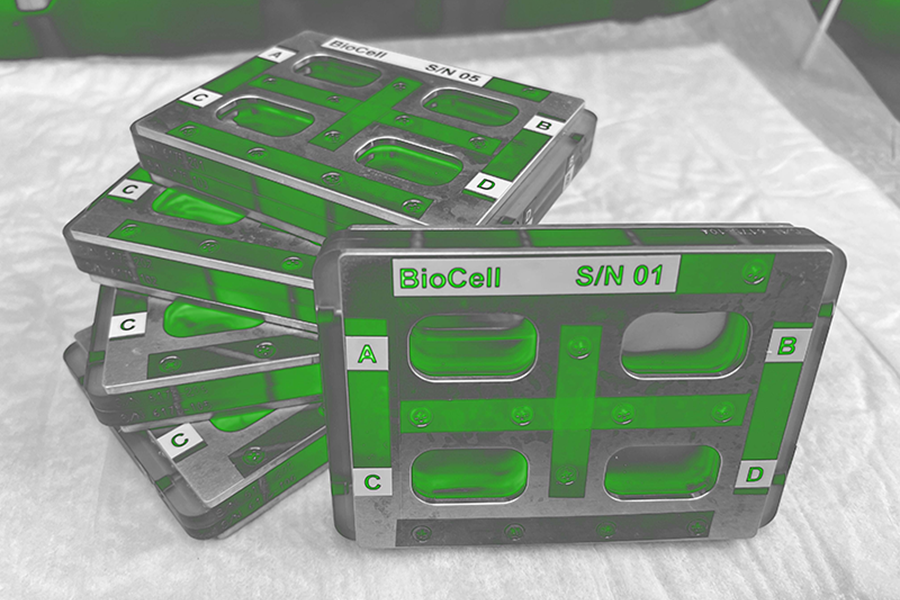Media Advisory: To Find Answers for People on Earth, NIH-Funded Tissue Chip Models Take Flight

Researchers at the University of California, San Francisco (UCSF) are using tissue chips, 3-D bioengineered models of living organs and tissues, to study the impact of an aging immune system on the body’s ability to heal injured tissue. Tissue chips allow scientists to examine the effects of culturing immune cells and cells called mesenchymal stem cells (MSCs) in space, imitating how they interact in the body. MSCs are important for making and repairing tissues such as cartilage and bone. (Sonja Schrepfer, M.D., Ph.D., UCSF)
July 13, 2022
WHAT: Two National Institutes of Health-funded research teams will send tissue chips — tiny, 3-D bioengineered models of living organs and tissues built from human cells — to the International Space Station National Laboratory (ISS-NL). The tissue chips will spend several weeks in orbit to collect information about why the aging process causes muscles to lose mass and strength and why the immune system works less effectively. The projects will be aboard the SpaceX CRS-25, which is scheduled to lift off no earlier than July 14 from NASA’s Kennedy Space Center in Cape Canaveral, Florida.
Scientists have been using the low-gravity conditions of space as a laboratory for decades. When astronauts spend time in space, their bodies change. Many of these physiological changes are like the effects seen in aging. Studies using tissue chips on the ISS provide a unique opportunity for researchers to model and study conditions related to diseases and aging over weeks, rather than the years that it would take for these conditions to develop on Earth. In many cases, investigators also are using this unique environment to test potential therapies to mitigate aging effects.
The projects are funded through the Tissue Chips in Space program, a collaboration among NIH’s National Center for Advancing Translational Sciences (NCATS) and National Institute of Biomedical Imaging and Bioengineering (NIBIB) and the ISS-NL.
WHEN: The launch is scheduled for no sooner than July 14, 2022, at 8:44 p.m. EDT; monitor twitter.com/Space_Station for schedule changes.
WHERE: Cape Canaveral, Florida
NIH SPOKESPEOPLE:
Joni L. Rutter, Ph.D., Acting Director, NCATS
Danilo A. Tagle, Ph.D., Director, NCATS Office of Special Initiatives
To schedule interviews with NCATS staff, please email ncatsinfo@mail.nih.gov.
PROJECT DETAILS:
- Researchers at the University of California, San Francisco (UCSF) are using tissue chip technology to better understand how a person’s aging immune system can affect the body’s ability to heal injured tissue. Scientists know that immune cells can work less efficiently as people age, dimming the immune response (termed immunosenescence). They think that certain immune cells are tied to the ability of stem cells to regenerate tissue and heal injuries and wounds. The UCSF team is examining the effects of culturing immune cells and stem cells in space. Their initial space experiments revealed that immune cells showed accelerated aging, which hindered stem cells’ abilities to repair damaged tissue. When the current flight’s cells return to Earth, the scientists will analyze the changes to the cells’ biology and how these changes reverse in time on the ground. They hope this information will provide insights to improve the function of aging immune cells.
- Researchers at the University of Florida are using tissue chips to examine the loss of muscle strength and mass in space, which is similar to what happens in people as they age (a condition called sarcopenia). They will compare muscle cells derived from athletic, young volunteers and from sedentary, older ones, including the cells’ response to electrical stimulation on Earth and in space. When the project returns to Earth, the team will study genetic changes in the cells. Insights from the project could lead to new therapies to treat and even prevent muscle-wasting diseases. On a subsequent trip to the ISS, expected in the fall, the team will use the tissue chips to examine the effectiveness of a candidate drug in preventing muscle loss.
MORE INFORMATION:
For more information on NCATS and its tissue chip program, see:
About the National Center for Advancing Translational Sciences (NCATS): NCATS conducts and supports research on the science and operation of translation — the process by which interventions to improve health are developed and implemented — to allow more treatments to get to more patients more quickly. For more information about how NCATS helps shorten the journey from scientific observation to clinical intervention, visit https://ncats.nih.gov.
About the National Institute of Biomedical Imaging and Bioengineering (NIBIB): NIBIB’s mission is to improve health by leading the development and accelerating the application of biomedical technologies. The Institute is committed to integrating engineering and physical sciences with biology and medicine to advance our understanding of disease and its prevention, detection, diagnosis and treatment. NIBIB supports emerging technology research and development within its internal laboratories and through grants, collaborations and training. More information is available at the NIBIB website: https://www.nibib.nih.gov/.
About the National Institutes of Health (NIH): NIH, the nation’s medical research agency, includes 27 Institutes and Centers and is a component of the U.S. Department of Health and Human Services. NIH is the primary federal agency conducting and supporting basic, clinical and translational medical research, and is investigating the causes, treatments and cures for both common and rare diseases. For more information about NIH and its programs, visit https://www.nih.gov.


